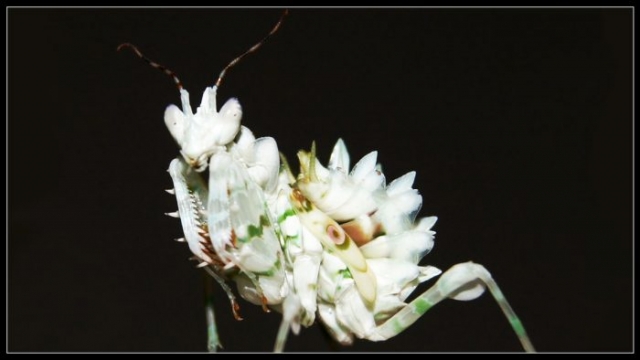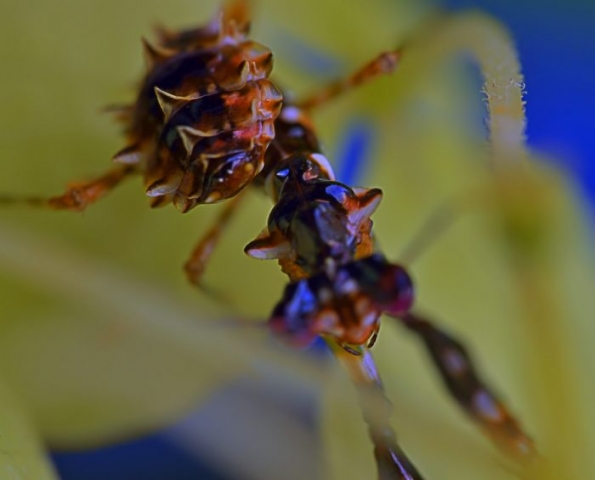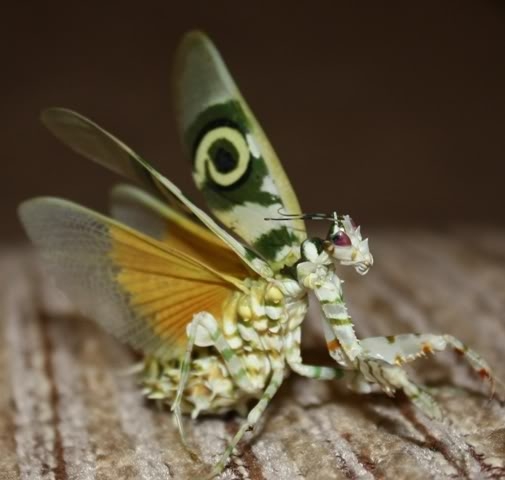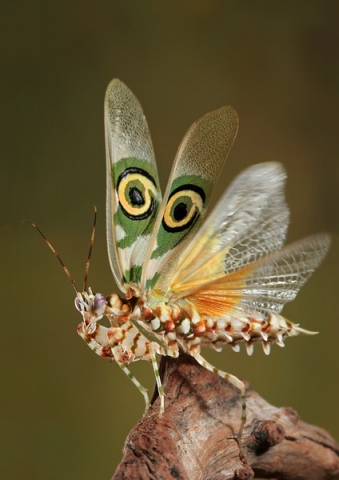Click here to buy Spiny Flower Mantis ootheca
Looks
A fantastically vibrant species as adult, bearing a multicoloured eye on the wing case, and a small number 9 on the side of the abdomen.
The Spiny Flower Mantis has an array of colours on its body and wing case, from light brown, to green, to red, to blue, and mixes of each. The main colours are only really displayed as adult, in males and females, on the wing case. Both sexes possess fully grown wing cases, with the same patterning. However, the male is slightly shorter than the females, and much more slender. Sex determination is the usual, 8 segments for the male, nd 6 or 7 for the female. Antennae are very similar, so this may be an inaccurate way of sex determination. However, the male does possess slightly longer antennae, but this length difference will only be visible from L5 upwards. You will also notice that the female will have small, rubbery spines exposed around the edge of her wing case, however, the male will not. The Pseudocreobotra is a fairly small species, growing from 4-5 cm in length.
Humidity and Temperature
The Spiny Flower Mantis is native Africa, East to South. In these areas, temperatures can reach high of around 35c. In captivity, they are best kept at around 25-30c. This temperature can be stimulated with a heat mat, or the enclosure can be sat on top of a heated enclosure. In the summer, this extra heat is not usually needed, but must be used for the colder months. Humidity is not essential, although this species does like to drink. Spraying around 2-3 times a week will provide enough moisture and humidity.
Housing and Enclosure
The Pseudocreobotra is prone to mould, and fungal infection, so a ventilated enclosure is essential. There are various different ways of creating a ventilated enclosure, the easiest by simply using a tank, with a ventilated lid. Some enclosures will have a mesh back to them, which is also great to use. Furnishing must be used, as this species likes to hide in between flowers, twigs, and any other form of cover. You will find they sit in the same perch for long periods of time, sometimes even days Don’t make the enclosure to large, as they do not hunt for their food, they are more of a sit and wait species. It will need to be up to three times the height of the mantis, for shedding purposes, and the tank must not be to clogged with foliage, to allow room to hang down whilst shedding.
Living on plants in their natural habitat, the Pseudocreobtra will eat mainly flying, pollinating insects. It is best to stimulate this in the UK, by providing them with flies, moths, and any other flying insect. If you cannot use these, then a mixture of crickets, locusts, wax worms, mealworms, and any other live food available in captivity will be okay. You will find that once you have put the food in the enclosure, it will be eaten fairly quickly. This is a ferocious species, and anything that walks past, will not be left. The only time you will find this species not to be interested in food, will be just before it is shedding (where it will remain in the same place for a long period of time, and wing buds will inflate.)
Breeding
Breeding can be difficult with the Spiny Flower Mantis, so you must ensure that the females are well fed, as they will often show aggressive behaviour towards the male.
Ootheca should be incubated at around 25-30c, and sprayed 2-3 times per week. You can expect to hatch anywhere between 30 and 50 nymphs from a single Pseudocreobotra ootheca.
Summary
The Spiny Flower Mantis is a wonderful species for any hobbyist. It is not hard to care for, so easy for the beginner, and one of the most beautiful of all species, and something that might be of interest to any collection. The only reason I would say this species would be a drawback as a starter mantis, is because it does not like to be handled, and can have quite a nasty bite when it spots a wondering finger!
Pseudocreobotra (Spiny Flower Mantis) Gallery
Please note the photos below have been collected from the web for reference, and each image links back to it’s original source. I don’t claim any copyright over these, and if you’ve got an image here that you’re not comfortable with and would like to be removed, then please get in touch.







Pseudocreobotra Wahlbergii (Spiny Flower Mantis) discussion:
Feel free to post any comments on this species below:
Hi! I’m new to owning a praying mantis and was wondering where I can purchase a nice and beautiful species like this one?
Hi Eric, please drop me an email using the contact link and I’ll send you an up to date species list, at the moment I don’t have any pseudocreobotra available. Thanks.
I don’t know where to buy one eather
My son who now is in heaven loved praying mantis. I will love to see your inventory on what species you have. Right now I just bought a baby orchid praying mantis and put it in his room in memori of my sunshine who was taken away from me and who I missed so much.
Hey. Do you know any websites where I could buy a spinyflower mantis.??